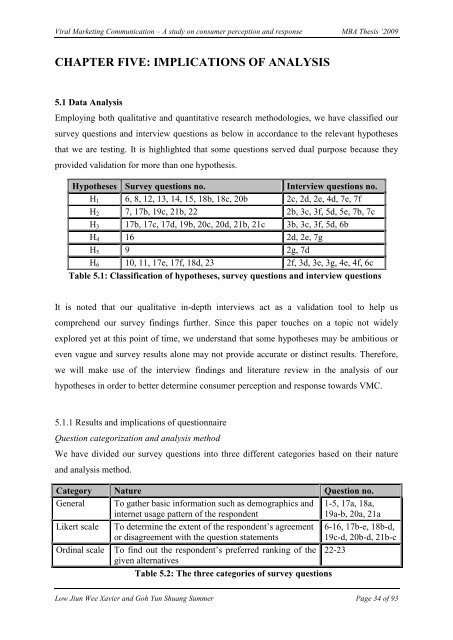Viral Marketing Communication: The Internet Word-of-Mouth
Viral Marketing Communication: The Internet Word-of-Mouth
Viral Marketing Communication: The Internet Word-of-Mouth
Create successful ePaper yourself
Turn your PDF publications into a flip-book with our unique Google optimized e-Paper software.
<strong>Viral</strong> <strong>Marketing</strong> <strong>Communication</strong> – A study on consumer perception and response MBA <strong>The</strong>sis ’2009<br />
CHAPTER FIVE: IMPLICATIONS OF ANALYSIS<br />
5.1 Data Analysis<br />
Employing both qualitative and quantitative research methodologies, we have classified our<br />
survey questions and interview questions as below in accordance to the relevant hypotheses<br />
that we are testing. It is highlighted that some questions served dual purpose because they<br />
provided validation for more than one hypothesis.<br />
Hypotheses Survey questions no.<br />
Interview questions no.<br />
H 1 6, 8, 12, 13, 14, 15, 18b, 18c, 20b 2c, 2d, 2e, 4d, 7e, 7f<br />
H 2 7, 17b, 19c, 21b, 22 2b, 3c, 3f, 5d, 5e, 7b, 7c<br />
H 3 17b, 17c, 17d, 19b, 20c, 20d, 21b, 21c 3b, 3c, 3f, 5d, 6b<br />
H 4 16 2d, 2e, 7g<br />
H 5 9 2g, 7d<br />
H 6 10, 11, 17e, 17f, 18d, 23 2f, 3d, 3e, 3g, 4e, 4f, 6c<br />
Table 5.1: Classification <strong>of</strong> hypotheses, survey questions and interview questions<br />
It is noted that our qualitative in-depth interviews act as a validation tool to help us<br />
comprehend our survey findings further. Since this paper touches on a topic not widely<br />
explored yet at this point <strong>of</strong> time, we understand that some hypotheses may be ambitious or<br />
even vague and survey results alone may not provide accurate or distinct results. <strong>The</strong>refore,<br />
we will make use <strong>of</strong> the interview findings and literature review in the analysis <strong>of</strong> our<br />
hypotheses in order to better determine consumer perception and response towards VMC.<br />
5.1.1 Results and implications <strong>of</strong> questionnaire<br />
Question categorization and analysis method<br />
We have divided our survey questions into three different categories based on their nature<br />
and analysis method.<br />
Category Nature Question no.<br />
General To gather basic information such as demographics and 1-5, 17a, 18a,<br />
internet usage pattern <strong>of</strong> the respondent<br />
19a-b, 20a, 21a<br />
Likert scale To determine the extent <strong>of</strong> the respondent‟s agreement 6-16, 17b-e, 18b-d,<br />
or disagreement with the question statements<br />
19c-d, 20b-d, 21b-c<br />
Ordinal scale To find out the respondent‟s preferred ranking <strong>of</strong> the 22-23<br />
given alternatives<br />
Table 5.2: <strong>The</strong> three categories <strong>of</strong> survey questions<br />
Low Jiun Wee Xavier and Goh Yun Shuang Summer Page 34 <strong>of</strong> 93


